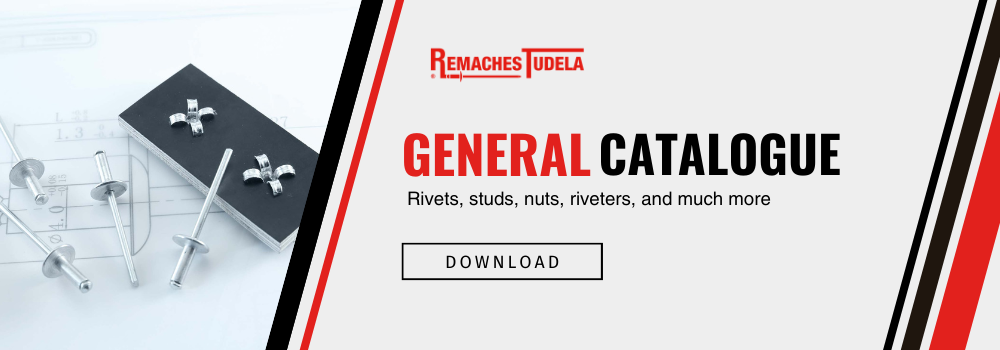In the world of industry and construction, joining parts and materials is a fundamental task. In the search for solid and durable connections, rivets have proven to be essential fastening elements. They are versatile, reliable, and adapt to a wide variety of applications and materials. However, not all rivets are the same, and choosing the right type for a specific task is crucial for the success of the project.
In this blog post from Remaches Tudela, a leading company in the manufacture of fastening systems since 1982, we detail what rivets are, the different types of rivets available on the market, and their main differences.
What are rivets
Rivets are fastening elements used in a wide variety of industrial and construction applications to securely and permanently join two or more pieces. Unlike other joining methods such as screws or welds, rivets do not require the use of electric tools or heat, which makes them a versatile and easy-to-use option.
These devices consist of a body that is deformed in a controlled manner when struck or compressed by another tool or by a stem or nail mounted on the body, creating a solid and reliable joint.
Their versatility makes them suitable for a wide range of materials, from metals and plastics to wood and composite materials. Rivets are essential in the construction of structures, product manufacturing, and many other applications where secure material joining is fundamental.
Parts of a rivet
Rivets consist of different parts such as the head, the nail, and the body. The thickness to be riveted and the counter-head are specific characteristics of the rivet.
Different types of rivets
You will find rivets of different types and sizes to adapt to various applications and customer needs. Below we show you some of the most common types and sizes:
Types of impact rivets
- Solid rivets: these are the simplest rivets and consist of a cylindrical body and a head. They are installed by striking the headless end until it deforms and secures the pieces.
- Semi-tubular rivets: they have a body with a hole at the end up to a certain depth that deforms when struck. They are used in applications where it is necessary to join softer materials such as leather or fabric.
- Hollow rivets: these rivets have a hollow body that deforms when struck, creating a permanent joint. They are ideal for applications where a light but strong joint is needed.
Types of rivets according to the head of the body
- Countersunk head rivets: these rivets are used when a flat surface is required in the joint. The head sinks into the material and can be easily hidden.
- Round head rivets: they have a round head that protrudes from the material. They are ideal for applications where a visible joint is needed.
- Large head rivets: these rivets have a larger head that provides greater tensile strength. They are used in applications that require strong fastening.
Types of blind rivets
- Pop rivets: pop rivets, also known as blind rivets, are versatile and easy to use. They are inserted into a hole in the pieces to be joined and are fixed with a specialized tool that pulls the stem and creates a secure joint.
- Pull rivets: these blind rivets are used in applications that require a temporary joint that can be easily dismantled. They are inserted and fixed by pulling the stem and can be removed if necessary.
Types of aluminum rivets
- Solid aluminum rivets: they are lightweight and corrosion-resistant, making them ideal for outdoor applications. They are commonly used in the aerospace and automotive industries.
- Large head aluminum rivets: these aluminum rivets have a larger head that provides a greater fastening area. They are ideal for joining thicker aluminum pieces.
Types of metal rivets
- Steel rivets: these rivets are ideal for high-strength applications. They are used in the construction of bridges, ships, and other robust structures.
- Stainless steel rivets: they are corrosion-resistant and are used in applications where exposure to water or other corrosive elements is a factor.
- Titanium rivets: known for their strength and lightness, titanium rivets are used in aerospace and high-technology applications.
Classes of rivets
In addition to the different types and sizes of rivets, there are also classes that are used according to the application and desired performance. Here are some common classes of rivets:
Class 1: sandard rivets
These rivets are the most common and are used in a wide variety of applications. They are easy to install and provide a solid and reliable joint.
Class 2: High-Performance rivets
Class 2 rivets are designed for applications that require exceptional strength and durability. They are used in the construction of heavy structures and industrial machinery.
Class 3: structural rivets
These rivets meet specific strength standards and are used in applications where safety is paramount, such as the construction of bridges and buildings.
Class 4: aerospace rivets
Class 4 rivets are ideal for applications in the aerospace industry where extremely high levels of performance and corrosion resistance are required.
Types of rivets for different materials
Depending on the type of work you have to do and the material you have to use, you should choose a specific rivet not only for safety but also to ensure the work is in the best possible condition. Below is a brief review of the types of rivets available for different materials.
Rivets for metal
- Steel rivets: ideal for joining thick metal pieces or structures that require high strength. Steel rivets can withstand heavy loads and are used in industrial and construction applications.
- Aluminum rivets: lightweight and corrosion-resistant, making them ideal for joining aluminum pieces. They are commonly used in the manufacture of automobiles, aircraft, and consumer products.
- Copper rivets: copper rivets are excellent electrical conductors and are used in electrical and electronic applications. They are also corrosion-resistant and can be used in humid environments.
Rivets for plastic
- Plastic rivets: these rivets are specifically designed to join plastic pieces. They provide a secure fastening without damaging the plastic material.
Rivets for wood
- Wood rivets: used to join wooden pieces in carpentry and furniture construction applications. Wood rivets have a special shape that allows a firm fit in wood holes.
Rivets for composite materials
- Carbon fiber rivets: these rivets are ideal for joining carbon fiber composite materials, commonly used in the aerospace and automotive industries.
Rivets for mixed materials
- Multicomponent rivets: designed to join mixed materials such as metal and plastic. They are versatile and used in a variety of applications.
- Metal on plastic rivets: these rivets combine a metal stem with a plastic head and are used to effectively join metal to plastic.
- Metal on wood rivets: these rivets are designed to join metal pieces to wood. They provide a solid fastening on both surfaces.
Choosing the right type of rivet for a specific material is essential to ensure the integrity of the joint and the durability of the project. It is always advisable to consult a professional or follow the manufacturer’s recommendations to select the correct rivet according to the material and application.
As you can see from this post, rivets are fundamental elements in a wide range of industrial and construction applications. The selection of the right type, size, and class of rivet depends on the materials to be joined and the specific requirements of the application.
With this information, manufacturers and builders can make informed decisions to ensure the integrity and durability of their projects. It is always important to consult a professional or a fastening expert like Remaches Tudela to ensure the correct selection of rivets for any project.
At Remaches Tudela, we are committed to providing a wide range of high-quality rivets and expert advice to help you select the right rivets for your specific project.
If you have any questions or need assistance, visit our website or contact us. We are here to help you achieve safe and durable joints in your applications.
.



